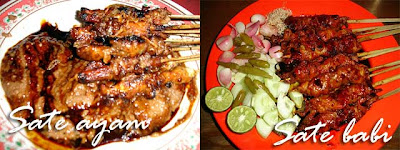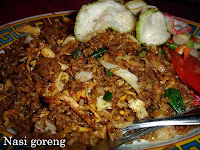 On top of that list is the sate ayam or grilled chicken skewers in Jalan Sabang, Jakarta. What makes this dish a winner, given that there are sate or satay is found around the Malay region, is the saos kacang or peanut sauce which tastes like heaven! I also had sate babi or grilled pork skewers in Kelapa Gading, but the accompanying sauce was the regular barbeque sauce we have here in the Philippines.
On top of that list is the sate ayam or grilled chicken skewers in Jalan Sabang, Jakarta. What makes this dish a winner, given that there are sate or satay is found around the Malay region, is the saos kacang or peanut sauce which tastes like heaven! I also had sate babi or grilled pork skewers in Kelapa Gading, but the accompanying sauce was the regular barbeque sauce we have here in the Philippines. Of course, there are the nasi or rice dishes. I enjoyed the really sweet nasi gudeg in Yogyakarta. This dish is actually several dishes put together. As I mentioned in an earlier post, I got to visit the kitchen to see it being made. The first component dish, duck eggs are first hard-boiled, then shelled, then re-boiled again with different ingredients and spices until it reaches a dark brown color. Another component is the chicken dish. They were also grating coconuts and chopping some young jackfruit at the back for another dish. There was also a tofu and cow skin dish. The last component was white rice. They prepared large servings beginning the night before for sales the next day.
Of course, there are the nasi or rice dishes. I enjoyed the really sweet nasi gudeg in Yogyakarta. This dish is actually several dishes put together. As I mentioned in an earlier post, I got to visit the kitchen to see it being made. The first component dish, duck eggs are first hard-boiled, then shelled, then re-boiled again with different ingredients and spices until it reaches a dark brown color. Another component is the chicken dish. They were also grating coconuts and chopping some young jackfruit at the back for another dish. There was also a tofu and cow skin dish. The last component was white rice. They prepared large servings beginning the night before for sales the next day. Nasi liwet is boiled rice with sambal goreng labu siam which is fried labu siam or chayote with chili and coconut milk. The dish is also served with chicken also boiled in coconut milk and a hard-boiled egg. I had this dish in Kelapa Gading and it was quite tasty. I also had ayam goreng (fried chicken) with nasi putih (white rice), lalap (vegetables) and sambal (chili) at a warung in Yogyakarta. They say the chicken is marinated in coconut milk.
Nasi liwet is boiled rice with sambal goreng labu siam which is fried labu siam or chayote with chili and coconut milk. The dish is also served with chicken also boiled in coconut milk and a hard-boiled egg. I had this dish in Kelapa Gading and it was quite tasty. I also had ayam goreng (fried chicken) with nasi putih (white rice), lalap (vegetables) and sambal (chili) at a warung in Yogyakarta. They say the chicken is marinated in coconut milk. The most popular rice dish is nasi goreng which is literally fried rice. The rice is fried in kecap manis or soy sauce and is often accompanied by additional items such as a fried egg, fried chicken, sate or krupuk (fried crackers made of shrimp or vegetables).
The most popular rice dish is nasi goreng which is literally fried rice. The rice is fried in kecap manis or soy sauce and is often accompanied by additional items such as a fried egg, fried chicken, sate or krupuk (fried crackers made of shrimp or vegetables).Then there are the salads. Gado-gado is a vegetable salad served with a peanut sauce dressing. The vegetables, which may include shredded or chopped green vegetables such as cabbage, cauliflower, green beans, watercress, and bean sprouts; carrots, cucumber, peas and tomatoes, are either served raw or blanched.
 Sliced boiled potatoes and boiled eggs are sometimes added. This whole mixture is topped with the peanut sauce and krupuk.
Sliced boiled potatoes and boiled eggs are sometimes added. This whole mixture is topped with the peanut sauce and krupuk. Ketoprak is another Indonesian salad which is noodles, tofu, bean sprouts and vegetables topped with peanut sauce and served with krupuk. Then there is the tahu goreng medan which is tofu, bean sprouts, vegetables, topped with peanuts, fried garlic and a sweet soy and chili sauce.
Ketoprak is another Indonesian salad which is noodles, tofu, bean sprouts and vegetables topped with peanut sauce and served with krupuk. Then there is the tahu goreng medan which is tofu, bean sprouts, vegetables, topped with peanuts, fried garlic and a sweet soy and chili sauce. A favorite fruit salad is the rujak. The typical Indonesian fruit rujak consists of slices of assorted tropical fruits such as jambu air (water apple or macopa), pineapple, raw mangoes, bangkoang (jicama or singkamas), cucumber, kedondong (great hog plum or hevi) and raw red ubi jalar (sweet potato). Sometimes Malang variants of green apple, belimbing (star fruit or balimbing), and jeruk bali (grapefruit) are added.
A favorite fruit salad is the rujak. The typical Indonesian fruit rujak consists of slices of assorted tropical fruits such as jambu air (water apple or macopa), pineapple, raw mangoes, bangkoang (jicama or singkamas), cucumber, kedondong (great hog plum or hevi) and raw red ubi jalar (sweet potato). Sometimes Malang variants of green apple, belimbing (star fruit or balimbing), and jeruk bali (grapefruit) are added. But what made this fruit salad really tasty was the peanut sauce. The sweet and spicy-hot bumbu rujak (dressing) is usually made up of water, gula jawa (coconut sugar), asem jawa (tamarind), grinded sauted peanuts, terasi (shrimp paste), salt, and cabe rawit (red chilli). But the one we tried at Plaza Indonesia had rumba, an Acehnese fruit, instead of tamarind to make the sauce sour.
But what made this fruit salad really tasty was the peanut sauce. The sweet and spicy-hot bumbu rujak (dressing) is usually made up of water, gula jawa (coconut sugar), asem jawa (tamarind), grinded sauted peanuts, terasi (shrimp paste), salt, and cabe rawit (red chilli). But the one we tried at Plaza Indonesia had rumba, an Acehnese fruit, instead of tamarind to make the sauce sour.Lumpia semarang is like the regular lumpia we have here. It’s filled with bamboo shoots, dried shrimp (ebi in Indonesian) chicken or prawn. It's named after the capital city of Central Java in Indonesia, Semarang where it was created by Chinese immigrants.
 Roti cane, which comes from Aceh, is just like roti canai of Malaysia or roti prata of Singapore. It’s the curry sauce which makes it different since its redder than the others mentioned.
Roti cane, which comes from Aceh, is just like roti canai of Malaysia or roti prata of Singapore. It’s the curry sauce which makes it different since its redder than the others mentioned. I also had martabak telur sapi, which is thin dough filled with minced beef, garlic and onion, and vegetables, and fried on a griddle until it turns golden brown. In Indonesia, it is served with a sauce made of vinegar and palm sugar. It’s similar to the murtabak in Malaysia.
I also had martabak telur sapi, which is thin dough filled with minced beef, garlic and onion, and vegetables, and fried on a griddle until it turns golden brown. In Indonesia, it is served with a sauce made of vinegar and palm sugar. It’s similar to the murtabak in Malaysia. Pempek, a specialty from Palembang, are large fish balls or fish cakes with an egg inside. They are deep fried and served with a spicy vinegar sauce. It was sold with another dish called tekwan which is pempek with soup if I'm not mistaken. This is a tasty snack.
Pempek, a specialty from Palembang, are large fish balls or fish cakes with an egg inside. They are deep fried and served with a spicy vinegar sauce. It was sold with another dish called tekwan which is pempek with soup if I'm not mistaken. This is a tasty snack. For dessert, I had es campur, which literally means iced mix. In other words, it’s the Indonesian halo-halo. They put in kelapa muda (young coconut), avocado, cincau, jackfruit, kelapa kopyor (kaong), and tape (fermented cassava). It is then topped with shaved ice, condensed milk and pisang ambon (banana) syrup.
For dessert, I had es campur, which literally means iced mix. In other words, it’s the Indonesian halo-halo. They put in kelapa muda (young coconut), avocado, cincau, jackfruit, kelapa kopyor (kaong), and tape (fermented cassava). It is then topped with shaved ice, condensed milk and pisang ambon (banana) syrup. In Kota, we bought cincau from one of the street hawkers. It’s a cold drink of cincau (grass jelly) with ice and pandan syrup. Anyway, that was just the tip of the iceberg when it came to Indonesian dishes. But it kept me busy eating the whole time I was there!
In Kota, we bought cincau from one of the street hawkers. It’s a cold drink of cincau (grass jelly) with ice and pandan syrup. Anyway, that was just the tip of the iceberg when it came to Indonesian dishes. But it kept me busy eating the whole time I was there!


























